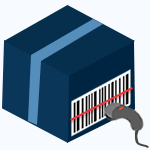Barcode & Labeling Compliance: What, How and Why
Barcode compliance is required to keep supply chains running such as manufacturers, suppliers, distributor and wholesaler. Compliance is two-part discipline that includes print quality and industry standard compliance such as GS1. Global Standards enable increased industry operational efficiencies and reduce the costs of operations.
Barcode supports industries to perform different supply chain operations. Whether online or in-store, the GS1 barcode is still the trusted foundation, helping businesses large and small to uniquely identify their products.
Organizations still struggle to maintain supply chain integrity, and one of the ways it is ensured is through barcode compliance.
Way to Ensure Barcode Compliance
Follow Customer Requirements and Encode Identity of Consumer Product

Many industries have agreed on standards for barcode types, label size, and placement on shipping packets and item labels. There are general "standard requirements" for industries to avoid conflict and fees by confirming barcode emplacement and size with each of their clients.
Instantly recognizable, EAN/UPC barcodes are printed on virtually every consumer product, and they are the longest-established and most widely-used of all the GS1 barcodes.
Printer Maintenance and Avoid Cheap Materials

You can certainly use thermal transfer or direct thermal printers to print barcodes because they produce accurate and high-quality images that have excellent edge definition. Printer maintenance should be conducted regularly to ensure that these machines are in good working condition.
In the case of a barcode label, low-grade materials can make barcode scanning too difficult. Saving money by using a cheaper label is not a good idea. A high-quality label has the power to grow your business, build your brand & inspire trust if the product meets requirements applying to the label.
Double Check Label Placement and Test your Barcode Labels by Verifier

Double-checking label placement on the box before shipping shows that you care about quality control. It’s not only important to make the barcode easy to find when it’s placed on the parcel, but also to make it easy to scan by a scanner device.
Barcode Verifiers are used for testing printed barcode label quality, scan ability, etc. The verifier will grade both linear (1D) and 2D barcodes according to quality parameters which are developed by international organizations like GS1.
Identify Products and Services

According to industry standards, you can ensure that your unique barcode numbers will be accepted by major retailers and distributors, and you can use a Global Trade Item Number (GTIN) to uniquely identify all of your company's trade items.
How to Improve Your Barcodes
Avoid Wrong Placement of the Barcode
Check that your barcode is not placed on a curved edge or a corner, because curved surfaces cannot be read easily by scanners, and make sure there is quiet space around your barcode.
Choose the Right Color Combination
Scanners are able to read barcodes only when there are dark bars on a light, contrasting background. Scanners measure the distance in contrast between spaces using red light, so it’s important to use colors that maximize this contrast.
Barcode Print Quality
Check for proper printing material, clear and visible lines, and any extra ink spots or damage that may have occurred during printing. Barcodes are always printed in black and white. Any other color will cause poor scanning conditions.
Accurate Barcode Data
Barcode structure with an incorrect start, stop or check digit is related to poor data quality and is a cause of barcode scan failure. Make sure that the barcode is correctly identified, ordered, and structured, which overcomes several challenges.